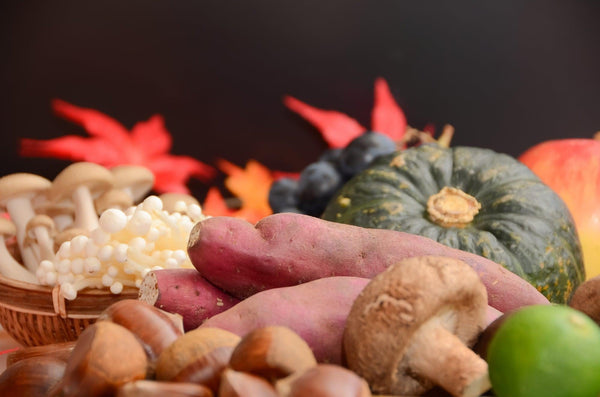
Jump to:
In Japan, people really love eating foods that are in season — and fall is no exception. From chestnuts to sweet potatoes to oysters to mushrooms, there are tons of popular autumn foods. This article will talk about each one and why seasonality is important in Japanese cuisine.
Why Is Seasonal Food Important In Japan?

Well, in Japanese cooking there is a philosophy known as shun. As Japan’s Agency for Cultural Affairs puts it, shun means choosing ingredients that are “. . . at their freshest and tastiest in that particular season.” When Japanese moms make sanma (a seasonal Japanese fish) for dinner in the fall, they’re practicing shun. When American moms buy watermelon in the summer they are . . . also practicing shun?
Another reason people eat foods that are in season is that sense of nostalgia and “confirmation” that the season has actually changed. For example, when the sweet potato trucks are driving around in Tokyo, you get this feeling of “ah, it’s really fall now.” Memories may come flooding back of the things you did in falls of the past (like a date with your boyfriend or going to a festival with your grandma). Much like in the West when grandma makes her famous pecan pie during the winter.
There are so many great autumn foods to eat in Japan. Here are some of the most popular.
Sweet Potatoes (Satsumaimo)
The Japanese sweet potato (satsumaimo) is a little different than the Western variety. They have purple or brown skin, a sweet taste and a starchy consistency. Here are two popular ways to eat them.
Yakiimo

Yakiimo (or yaki imo) is a roasted Japanese sweet potato (usually cooked on stones). Yaki means cooked or grilled and imo means potato. According to Food in Japan, “The origins of roasted sweet potatoes may be traced back to the Edo era.” One of the best ways to eat yakiimo in the fall is just to get some from the back of a yakiimo truck. They drive around the city selling them. You can make them yourself, too. Here’s our recipe!
Daigakuimo
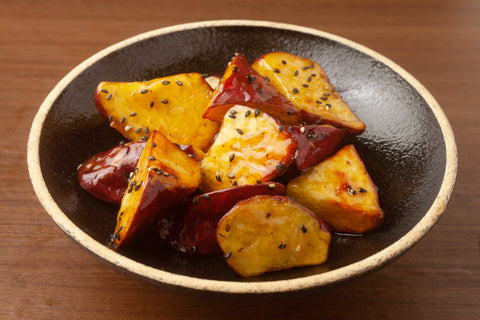
Another popular way to eat Japanese sweet potatoes is daigakuimo (or daigaku imo). This is a candied potato dish that’s sweet and crispy on the outside and tender on the inside. Daigaku means university, so you might be wondering how that name came about. Well, there’s a story (in Japanese) that says: “. . . a Tokyo University student who was struggling to pay for his studies made and sold [candied sweet potatoes], which quickly became popular among the students and [eventually] became a popular food [everywhere].” So, they called it “daigaku imo.”
Kabocha
What is kabocha? It’s a type of squash — but it’s more like a Japanese pumpkin. Some say the taste and texture is similar to acorn squash. It's a hard vegetable with a green outer skin and orange flesh. But, it’s sweet and tender once you cook it. Here are a couple of interesting ways to eat it.
Kabocha Korokke
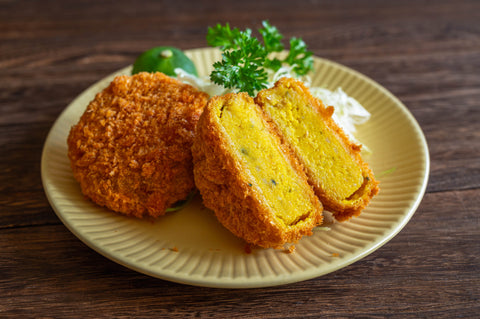
Korokke sounds sort of like karaoke, but it’s totally different. Korokke is a Japanese deep-fried potato patty (or ball) that was influenced by the French croquette. It’s crispy on the outside and mushy (yet tasty) on the inside. It can also be made with different ingredients. Kabocha korokke is made with Japanese pumpkin (kabocha) instead of regular potatoes.
Kabocha Pudding
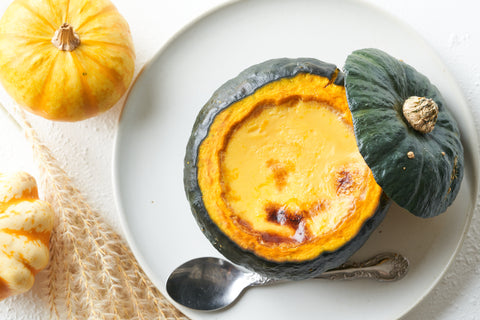
Japanese pudding (purin) is more firm and wobbly than Western style pudding — it’s more like a flan. Kabocha Purin includes (obviously) kabocha and has that nice pumpkin-y taste. Learn how to make it with our recipe!
Chestnuts (Kuri)
Japanese chestnuts (kuri) have a hearty texture, a bit of sweetness and a strong aroma. The flavor is a little like kabocha, actually. According to Google Arts & Culture, “Chestnut cultivation began in Japan during the Jomon Period more than 5,500 years ago.” People have been eating kuri for a long time! Chestnuts remain very popular in Japan — especially when they're in season (in the fall). People roast them, bake them and mix them in with other foods. At some festivals you’ll even see them boiling in big vats. Here are a couple of popular ways to prepare them.
Roasted Chestnuts
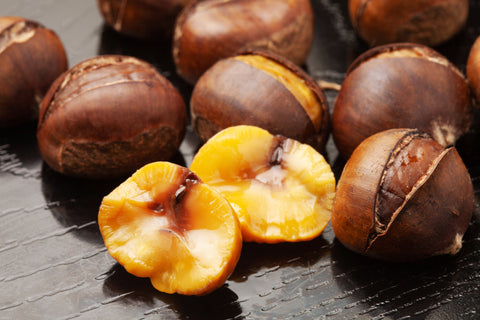
Roasted chestnuts are called yakiguri in Japanese. Yaki means roasted and guri means chestnut. Yakiguri is a simple, yet delicious way to eat chestnuts in the fall. The kuri can be roasted in different ways, on hot stones (much like roasted sweet potatoes) or just over an open flame on a grill.
Mont Blanc

This famous Japanese dessert is especially popular in autumn, but you can find it all year round. It’s sold at cafes and shops all over Japan. According to TimeOut, “Depending on the patisserie, noodles of sweetened chestnut puree may be piped onto a meringue, sponge or biscuit base, and in the center you’ll find a fluffy whipped cream filling.” Delicious!
Kurigohan
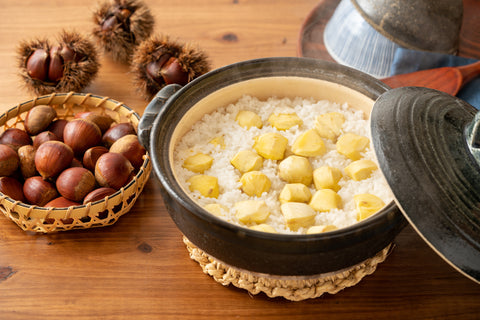
Gohan is one of the words for rice in Japan, and kuri (as mentioned earlier) is chestnut — so, kurigohan is chestnut rice! As you might imagine, this dish is basically rice with chestnuts (and a few other ingredients) cooked into it.
Fall Fruits
Like any country in the world, certain fruits are in season at different times. Here are some popular fall fruits in Japan.
Persimmons
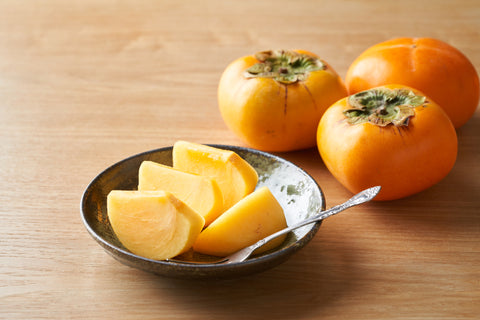
Some have called persimmons (kaki) “the national fruit of Japan” — a sweet fruit with an orange, jelly-like flesh that’s also high in nutrients. You’ve probably seen persimmons for sale in your part of the world, too. There are differences between Western and Japanese kaki, though. Check out this article by Tyrant Farms that explains them (it also talks about the different types of Japanese persimmons).
Pears (Nashi)
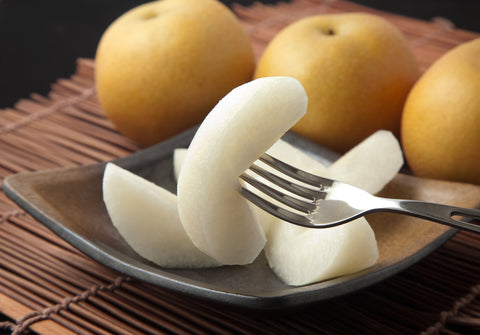
Japanese pears (aka asian pears) are called nashi. They are larger than Western pears, and have a shape and texture closer to a large apple. Nashi are lightly sweet, crisp and fairly juicy. Note: If you’re looking for a cough drop, there is a nashi flavored variety.
Grapes (Budou)
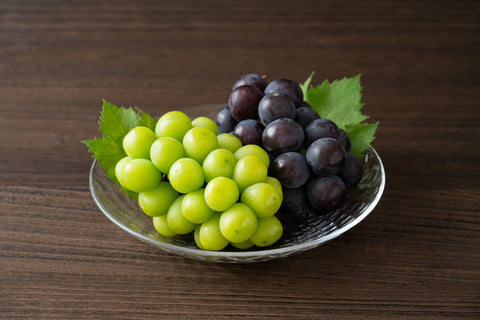
We all know this fruit — grapes are popular all over the world — not only for eating, but also for making wine. You can find many different kinds of grapes in Japan, but there is one type that is considered truly Japanese. It’s called koshu. They are grown in Yamanashi Prefecture and are primarily used for wine, but they’re nice to eat, too!
Fall Seafood
Sanma (Pacific Saury)
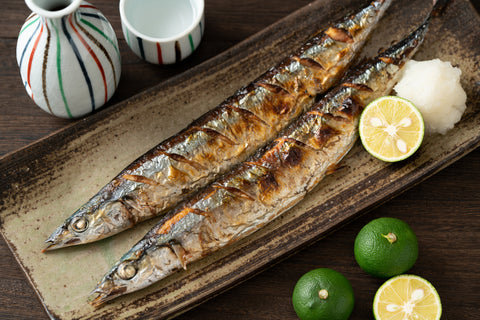
This fish is extremely popular in Japan. As Guidable explains, “Sanma is so synonymous with autumn that the kanji for its name translates literally to autumn sword fish.” Here’s the kanji: 秋刀魚 (sanma). 秋 means autumn, 刀 is sword and 魚 is fish. This fish is less than a foot long, and rather slender, but the meat is delicious. Some people compare it to mackerel. The most common way to prepare it is simply grill it and serve it with soy sauce and grated daikon (white radish).
Katsuo (Bonito)
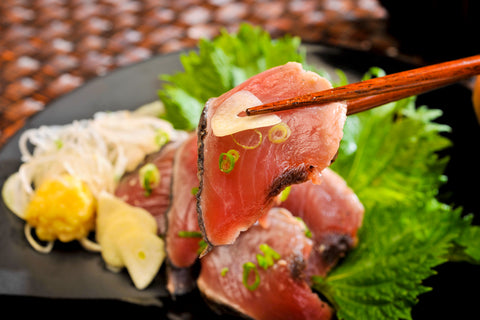
Katsuo is like the beef steak of fish. This delicious, meaty tuna (aka bonito, victor fish and way too many other names) is seasonal in both the spring and the fall. You’ll often see it served as tataki (almost like sashimi, but seared around the edges). It’s delicious with soy sauce or ponzu (the sauce made from Japanese citrus fruit, yuzu)!
Kaki Fry
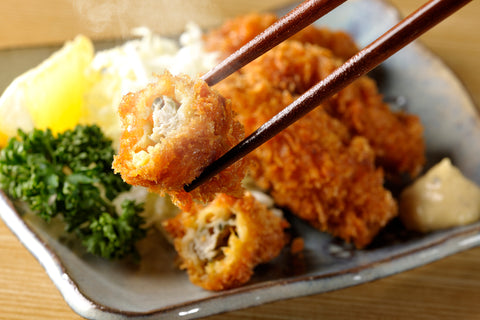
Kaki means oyster in Japanese, so you might have already guessed — kaki fry is Japanese fried oysters (kaki furai)! Oysters are in season in Japan starting around November. Fried oysters are juicy, with an ocean-y taste, and have a crispy, breaded coating. They are often dipped in tartar sauce and drizzled with tonkatsu sauce.
Mushrooms (Kinoko)
The only fungus to make this list — mushrooms! Mushrooms are called kinoko in Japanese, and they’re indeed considered a fall food (although people eat them all year round). One particular mushroom that you can’t get all year round is matsutake. Find out more below.
Matsutake Mushrooms
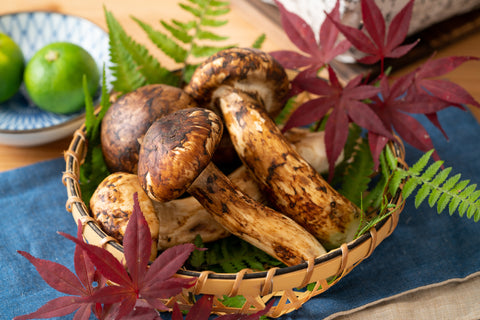
The matsutake mushroom is actually quite rare (it’s even considered a vulnerable species by the IUCN). It only grows in September and October and there just aren’t that many of them growing. This makes them quite expensive compared to other mushrooms. As far as flavor, they apparently have a strong, cinnamon-like aroma and taste a bit like pine.
Other Popular Japanese Fall Foods
Oden
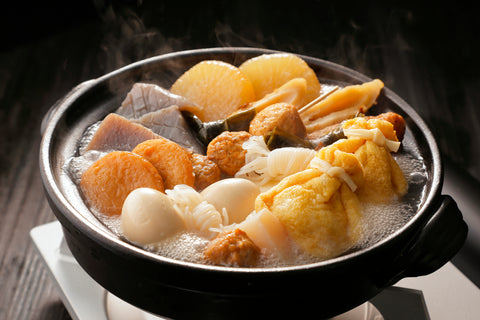
Another fall (and winter) dish that’s popular in Japan is oden. This is a Japanese soup-like dish made with a variety of chunky ingredients like boiled eggs, tofu, veggies and more. Depending on how it’s made, the flavor can be a little sweet or lean more toward a soy sauce feel. Try making oden yourself with our Kyoto-style recipe!
Shinmai
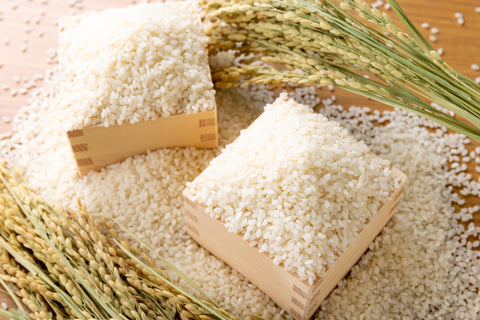
Are you a little elitist about your rice? If so, you should probably be eating shinmai instead of komai (or so some say). Shinmai is “new rice” and komai is “old rice.” Now, komai may not actually be that old at all — what makes the difference is the rice harvest season. For example, rice is mostly harvested in the fall. The rice from the harvest will be called shinmai (“new rice”). The rice that was already on the shelves from the previous season(s) is called komai (“old rice”).
Japanese people often say they can taste the difference between the two, but not everyone agrees that shinmai is better. A Japanese website did a survey that showed some people actually preferred komai with dishes like fried rice, curry, and even sushi!


0 comments